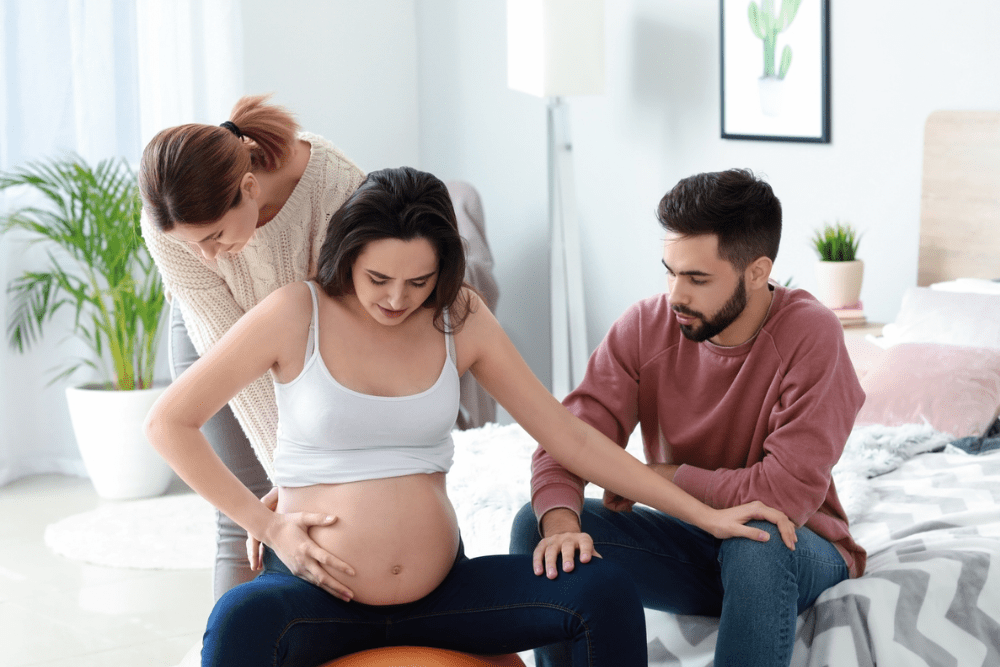As the birth approaches a woman’s body begins to prepare for the stage of labour. Signs that women may experience prior to labour include: Show (pink mucous discharge from the vagina), engagement of the baby’s head, more frequent Braxton Hicks contractions, a change in baby’s movements as they run out of space, weight loss of up to 1 kg, low pelvic pressure due to baby’s position, some diarrhoea and nesting behaviour (some women experience a surge in energy just prior to the birth).
Once conditions are right labour will commence. The hormone oxytocin is responsible for the strong, regular contractions of labour. Oxytocin release is triggered by a centre in the brain and it causes the uterus to contract. Labour contractions feel very different to Braxton Hicks contractions that women experience during their pregnancy. The most important difference is that labour contractions come regularly. Each one starts gradually, builds to a peak and then fades away. Typically when labour begins contractions are short in length, around 20 to 30 seconds long. As labour progresses, contractions become gradually longer and stronger.
Contractions need to be around 60 seconds long to dilate or open the cervix. Labour contractions can last up to 90 seconds. When a women gets true labour contractions they take all of her concentration and she is unable to talk through them. In about 10 to 15% of labours the waters will break first, before any contractions have occurred. In the remainder of labours, the waters will break towards the end of the first stage or in the second stage of labour (Robertson, 1999).
When should I go to the hospital?
Most women spend the early part of their labour at home. Advise as to when is the best time to come into hospital varies. The most important guide is the length and strength of the contractions. Remembering that contractions need to be around 60 seconds long before they efficiently dilate the cervix. It is less important to take note of the time between contractions. Contractions can be two minutes apart but be very mild in strength. You can contact the hospital and speak to a midwife if you are requiring guidance. You should contact the hospital if:
- You are experiencing regular, strong contractions
- Your waters break
- You start bleeding
How many stages does labour have?
Labour has three stages simply known as first, second and third stage. During the first stage of labour the opening of the uterus, called the cervix, goes from being closed to fully open (or 10cm dilated). The strong, regular contractions cause the cervix to open. During the second stage of labour the baby descends down the birth canal and is born. Women during the second stage of labour assist the birth of the baby by pushing during the contractions. The third stage of labour begins after the baby is born and ends with the birth of the placenta and membranes (or after birth).
 How long is labour?
How long is labour?
It is impossible to anticipate the length of labour. Every woman and every labour is individual. In general women expecting their first baby will take longer than women expecting a subsequent baby (though this does not always hold true). For a first baby, the average length of the first stage of labour is 12 to 14 hours, the second stage 1 to 2 hours and the third stage 5 to 60 minutes. Women expecting a subsequent baby can expect the first stage to last around 6 to 8 hours and the second stage lasting from 5 to 60 minutes. Remember that these are only averages. Women can have quick labours and long labours and anything in between (Robertson, 1999).
What can I do to help my self through labour?
Informing yourself of your many options is really helpful. You can do this by reading, attending prenatal classes or speaking to others. One of the main things that research has found helpful is the presence of continuous support person. This person may be your partner, friend, relative or an experienced labour support person.
It is important to feel comfortable in the environment you have chosen to give birth. You can make a labour room more comfortable by turning down the lights, closing the door, bringing some personal items and moving the furniture to suit your self. It is important to avoid dehydration in labour by drinking regularly. Eating small, light snacks in early labour is also helpful. Use up-right positions as these help stimulate the labour process and it is much easier to get comfortable (Robertson, 1999).
Reference List
Robertson, A. (1999). Preparing for birth: Mothers. Sydney: ACE Graphics.
(20th January 2000)



Recent Comments